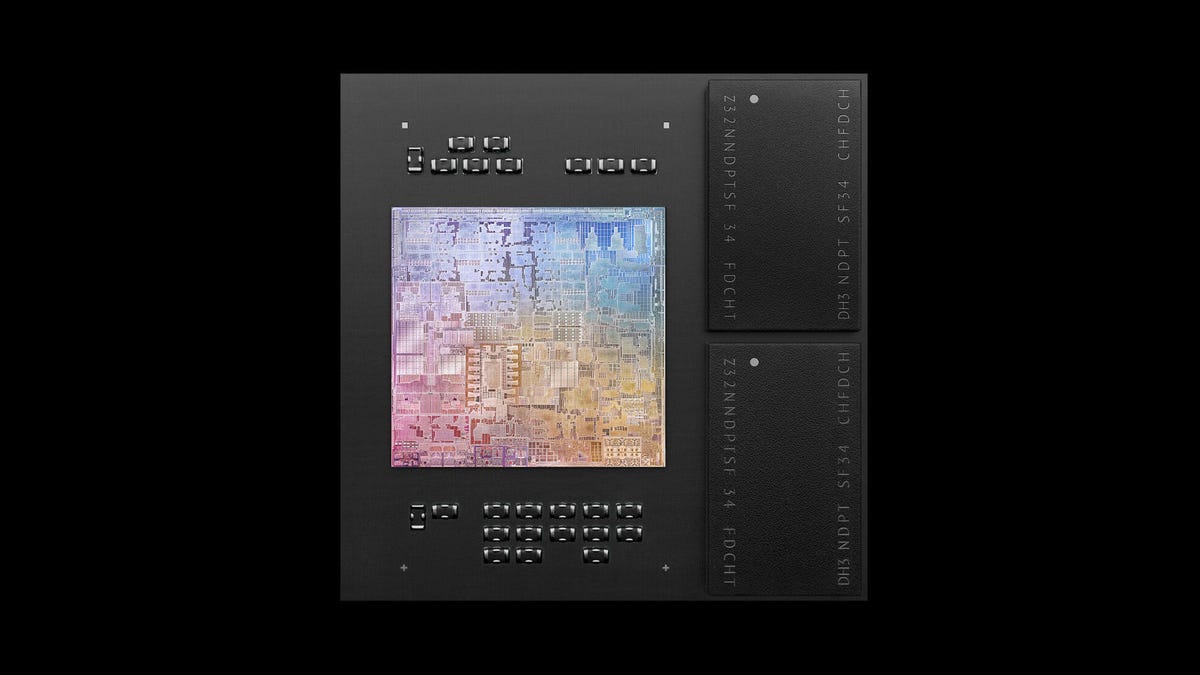Apple says its new M1 Mac chip delivers better speed, battery life
The eight-core chip is "by far the highest performance" processor the company has ever created, Apple says.

Apple's new Macs use a chip package combining the company's M1 processor brains, left, with two memory modules, right.
Apple's next-generation Macs will use a new chip called the M1, a big brother to the A14 chips in its iPhone 12, that Apple says will bring new power and battery life to its personal computers. The same M1 chip now powers new MacBook Air, MacBook Pro and Mac Mini models.
The company's goal with the chip is to achieve "industry leading performance and features while relentlessly focusing on performance efficiency," Johny Srouji, Apple's senior vice president of hardware technologies, said at an Apple launch event Tuesday. The new Macs will be joined by higher-end models in the next two years as Apple gradually ejects Intel from its personal computers.
In the Apple M1-based MacBook Air, the processor helps provide battery life that's good for "up to" 15 hours of web browsing and 18 hours of video. Processor speed is three and a half times faster than that of the previous Intel-based model, while graphics are five times faster, Apple said. The new 13-inch MacBook Pro is up to three times faster than the best-selling Intel machine, Apple said.
The processor has 16 billion transistors, a substantial increase from the 11.8 billion used in the iPhone 12's A14 Bionic. That lets Apple increase the number of central processing cores from six to eight. The M1 has four high-performance cores for heavy-duty work, compared with two on the iPhone 12, and four high-efficiency cores for low-priority tasks.
Like the iPhone and iPad chips, the M1 also has dedicated circuitry for graphics and artificial intelligence processing. Apple links these modules with a unified memory architecture, which means the computer doesn't have to waste time copying data internally as it switches processing approaches. The memory chips, while separate from the brains of the operation, are housed within the same chip package alongside processor for better speed.
Faster sustained performance on the MacBook Pro
The MacBook Air, MacBook Pro and Mac Mini use the same M1 processor, but the cooling fan in the MacBook Pro and Mac Mini will let the M1 run at top speed for longer. That should be helpful during video editing or other tasks that require sustained high performance.
Intel didn't comment specifically on Apple's claims but pointed to its new 11th-generation Core Tiger Lake laptop processors as evidence it's still competitive: "Intel is focused on delivering the most advanced PC experiences...We believe Intel-powered PCs-like those based on 11th Gen Intel Core mobile processors provide global customers the best experience in the areas they value most, as well as the most open platform for developers, both today and into the future."
Apple didn't detail the testing behind its performance claims, but it uses a combination of real-world software and synthetic benchmarks to test speed. Customers considering the new Macs might want to compare speeds to new Intel-based machines, not just previous-generation models.
Performance is crucial to the Mac chip transition, influencing whether Mac buyers embrace the new models enthusiastically, sit things out for a while or even buy a Windows machine powered by Intel's new Tiger Lake chips. With the coronavirus pandemic triggering a PC sales surge, it's prime time for Apple to try to lure as many customers as possible.
See also
One developer who writes Mac and iPhone software, Mark Pilkington, tweeted that was impressed by the processor. But he was displeased with the number of USB ports -- two on the new MacBooks -- and even more displeased with the 16GB memory maximum. Another developer, Benjamin Mayo, replied that he'll never buy a laptop with less than 32GB.
The M1 is just the first Apple Mac chip, though. Apple gave itself about two years to fully transition its Macs, including higher-end MacBook Pros with bigger screens that today are popular among developers, as well as iMacs and Mac Pros. Future models will doubtlessly offer more memory.
The M1 is a beefier version of the A14 Bionic used in the iPhone 12 and iPad Air. Differences include the two extra high-speed processing cores, twice the number of graphics processing cores, twice the memory communication speed and an ability to run at a faster clock speed overall.
Rosetta 2 software emulation can outpace Intel Macs
Good performance also means that Apple's Rosetta 2 technology, for running Intel Mac software on Apple silicon machines, is more useful during the chip transition. Apple software chief Craig Federighi said Rosetta can actually run some games faster than on Intel chips -- as long as developers adapt them to take advantage of Apple's Metal graphics technology.
The M1 chip includes other technology, too, including a built-in controller for handling Thunderbolt and USB 4 communications, a secure enclave for storing the most sensitive data, a signal processor for accelerated adjustments to photos and video, and engines to compress and decompress video and audio.
Apple Chief Executive Tim Cook announced the Apple silicon change at Apple's WWDC developer event in June. But it's been in the works for years, with rumors of Arm-based Macs extending back to 2012.
The MacBook Air starts at $999, while the smaller Mac Mini starts at $699 -- a $100 price cut that's likely easier to justify given analysts' expectation that Apple's chips are less expensive for the company than Intel's. The M1-based MacBook Pro starts at $1,299.
Apple boasts its M1 processor has the best performance per watt of power consumed, a key factor for long battery life.
Apple's M1 chip has a variety of abilities besides ordinary processing.

